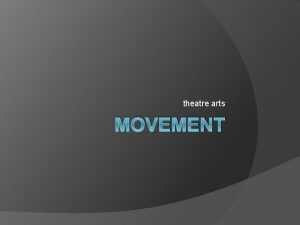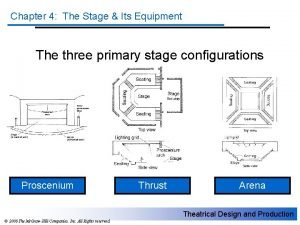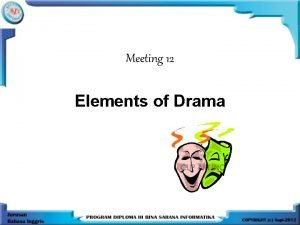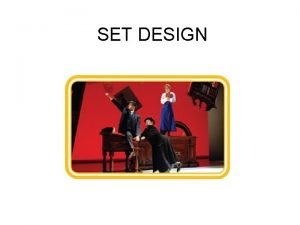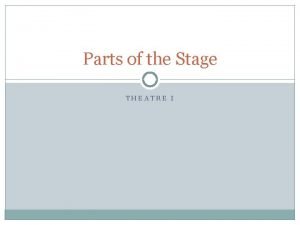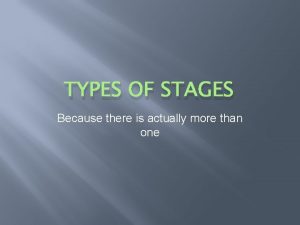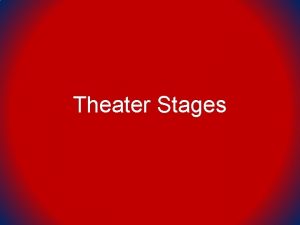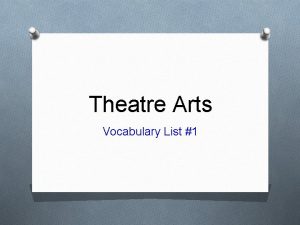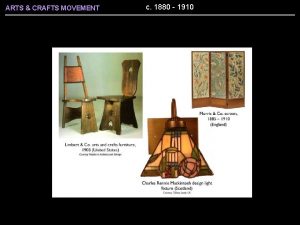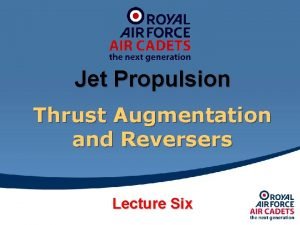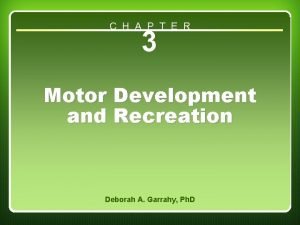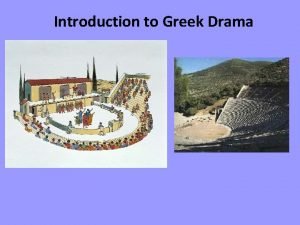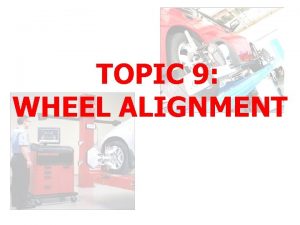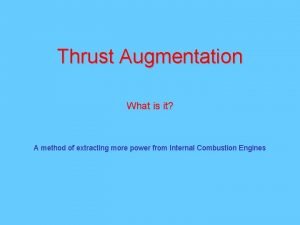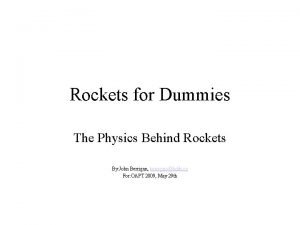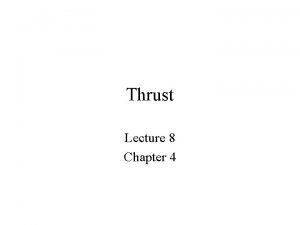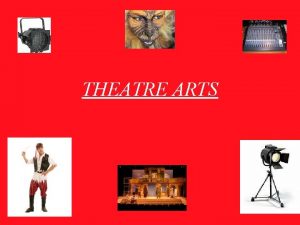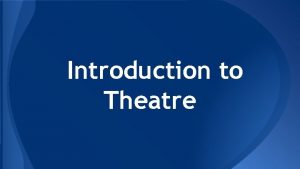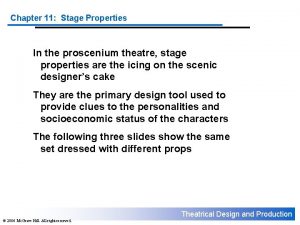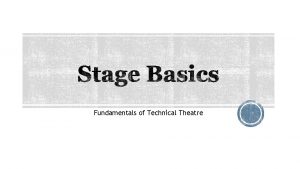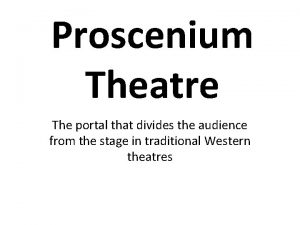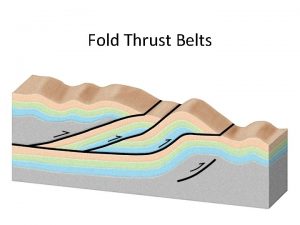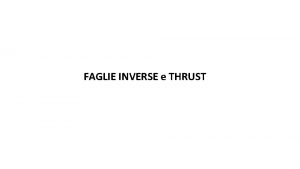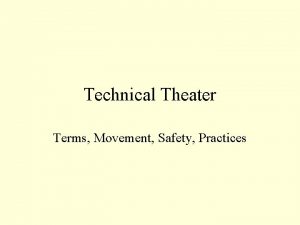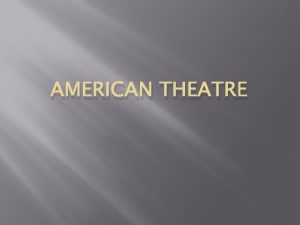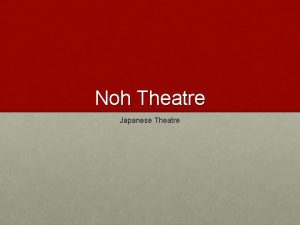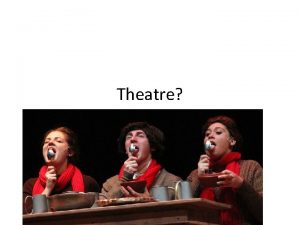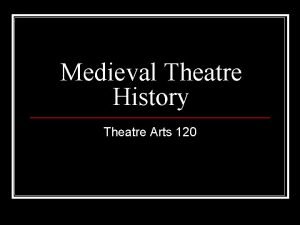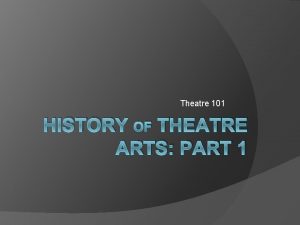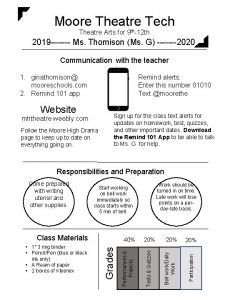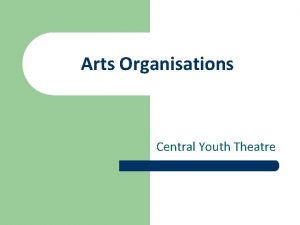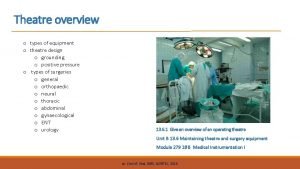theatre arts MOVEMENT TYPES OF STAGES PROSCENIUM THRUST




















- Slides: 20

theatre arts MOVEMENT

TYPES OF STAGES PROSCENIUM � THRUST � ARENA �

PROSCENI UM

Proscenium Stage PROSCENIUM ARCH AUDIENCE APRON

THRUS T

THRUST STAGE

ARENA “theatre in the round” • flexible seating

ARENA STAGE

STAGE DIRECTIONS proscenium & thrust stage only Strongest area

BODY POSITIONS FF-important lines ¼ - most dialogue scenes Profile: • intense scenes such as quarreling, accusing, romancing, etc. • used to obtain comic effects FB – used in special occasions

The Prime of Miss Jean Identify the body positions…

MOVEMENT All movement MUST be motivated or justified. � NO shuffling your feet, fidgeting, or nervously moving. � An actor should never move without a purpose. All movement must be simplified. � Use carefully chosen movement that clearly conveys your ideas. Movement must reveal character. A character’s personality, attitude, health & age SHOWS movement • Fat person vs. thin person; easy-going person vs. nervous person; Youth’s actions vs. older people. • Always move in character! •

BLOCKING The precise movement and positioning of an actor on a stage BLOCKING NOTATIONS � � � � EN – enter (to come in) EX – exit (to leave) X – to cross (or move from 1 stage area to another) CX – counter cross (move away) A – above (upstage of object) B – below (downstage of object) O – open up or “cheat out” (turn body, face to audience)

BLOCKING NOTATIONS � � � 1. DR 1/4 L 2. X UCFF 3. X UR 1/4 L 4. X CPRL 5. X DL 3/4 R 6. X UL-FF

Straight cross FLOOR PLAN • A bird’s eye view of the set, drawn to scale, showing placement of set pieces & furniture X Front door shortest, most direct route • Strength, decisiveness & determination Curved cross • indecision, casualness, grace, or ease Bath room Desk Windows

CHARACTER MOVEMENT When an actor adds DETAILED, physical action, which furthers the character’s believability and realism Mannerisms • Stage Business • Gestures •

CHARACTER MOVEMENT MANNERISMS • • Habits of the character without a prop Ex: bouncing leg, twirling hair, cracking knuckles STAGE BUSINNESS • • Habits of the character with a prop Ex: smoking, tapping a pencil, popping chewing gum GUESTURES using hand, arm, body, head or face movements to express thought or emotion • Ex: wave good bye or come here; frown, stick out tongue •

Identify the gesture, mannerism or stage business…

CHARACTER MOVEMENT WEIGHT • How light or heavy the character is on their feet; not the physical weight of the character TIME • The speed in which the character moves SPACE • The amount of space the character occupies or takes up POSTURE • The body position of the character as they move

MOVEMENT REMINDERS (all but arena) AWAYS…. . Use the upstage part of your body • Stay open to audience • Use motivated movement • Use detailed movement to show characterization • NEVER…. Break character • Pace, wonder or just stand there •
 Thrust stage birds eye view
Thrust stage birds eye view Proscenium thrust
Proscenium thrust What are the elements of drama?
What are the elements of drama? Thrust stage drawing
Thrust stage drawing Grand drape definition
Grand drape definition Black box stage pros and cons
Black box stage pros and cons Theatrical staging
Theatrical staging Arena stage disadvantages
Arena stage disadvantages Creative arts grade 8 term 3
Creative arts grade 8 term 3 Theatre arts vocabulary
Theatre arts vocabulary Arts and crafts movement 1880 to 1910
Arts and crafts movement 1880 to 1910 Thrust reverser types
Thrust reverser types Non movement area
Non movement area Locomotor dance steps
Locomotor dance steps Reflexive movement phase
Reflexive movement phase Animal fantasy makeup
Animal fantasy makeup What are the two types of greek drama?
What are the two types of greek drama? Steering axis inclination
Steering axis inclination Thrust augmentation methods
Thrust augmentation methods Contoh panggung thrust
Contoh panggung thrust Cummies rocket
Cummies rocket
